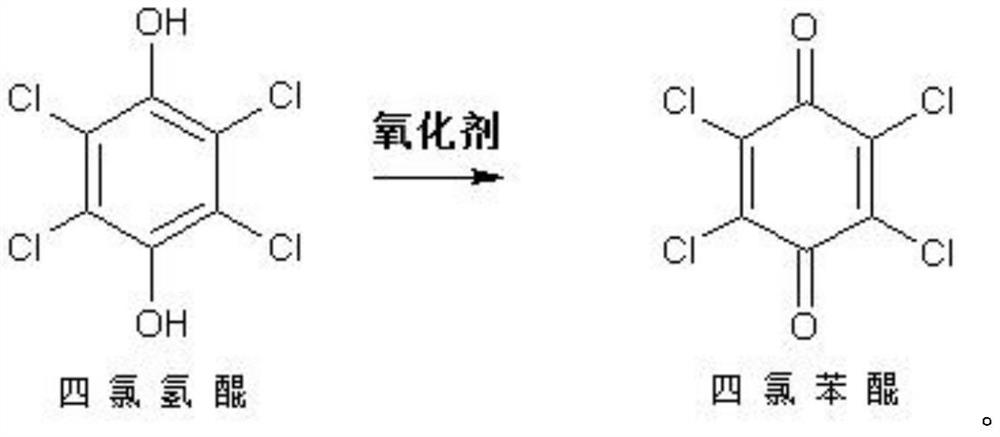Preparation method of chloranil
A technology of chlorobenzoquinone and chloroquinone, applied in the preparation of oxidized quinone, organic chemistry, etc., can solve the problems of low product purity and yield, unsuitability for industrial production, long reaction time, etc., and achieve cheap raw materials, The effect of short reaction route and easy availability of raw materials
- Summary
- Abstract
- Description
- Claims
- Application Information
AI Technical Summary
Problems solved by technology
Method used
Image
Examples
preparation example Construction
[0025]The present invention provides a preparation method of tetrachlorobenzoquinone, comprising the steps of:
[0026]Tetrachloronquinone and ice acetic acid were mixed with nitric acid or chlorine gas to be oxidized to give tetrachlorobenzene; when the oxidant was chlorine gas, the oxidation reaction was carried out under the presence of a catalyst.
[0027]The present invention uses ice acetic acid as a solvent, and the nitric acid or chlorine is oxidized as an oxidant, and tetrachlorobenzin is oxidized to obtain tetrachlorobenzene, and the reaction formula is as follows:
[0028]
[0029]The preparation method of the tetrachloroquinone provided by the present invention will be described in detail below according to the species of the oxidant.
[0030]In the present invention, when the oxidizing agent is nitric acid, it is specifically mixed with tetrachloride and ice acetic acid to perform an oxidation reaction under the presence conditions of nitric acid (referred to as the first oxidation re...
Embodiment 1
[0040]50 g of tetrachloride was mixed with 250 ml of ice acetic acid, the control temperature was 10 ° C, and a 10 ml concentration of 98 wt% was added dropwise, and the reaction was stirred at 10 ° C for 1 h, and the thin layer chromatographic analysis was complete; The resulting product system was filtered and the resulting filter was washed to neutral, and 10 h was dried at 60 ° C for 10 h, resulting in 49.1 g of tetrachlorobenzene, and the product was 99.2%, the yield was 98.2%.
Embodiment 2
[0042]50 g of tetrachloride was mixed with 500 ml of ice acetic acid, the control temperature was 20 ° C, and a 25 ml concentration of 70% by weight was added dropwise, and 45 min was added, and the reaction was stirred at 20 ° C for 0.5 h, and the thin layer chromatographic analysis was complete. The resulting product system was filtered, washed the resulting filter cake to neutral, and dried under 60 ° C for 10 h to give 49.2 g of tetrachlorobenzene, the product was 99.1%, and the yield was 98.4%.
PUM
| Property | Measurement | Unit |
|---|---|---|
| melting point | aaaaa | aaaaa |
Abstract
Description
Claims
Application Information
 Login to View More
Login to View More - R&D
- Intellectual Property
- Life Sciences
- Materials
- Tech Scout
- Unparalleled Data Quality
- Higher Quality Content
- 60% Fewer Hallucinations
Browse by: Latest US Patents, China's latest patents, Technical Efficacy Thesaurus, Application Domain, Technology Topic, Popular Technical Reports.
© 2025 PatSnap. All rights reserved.Legal|Privacy policy|Modern Slavery Act Transparency Statement|Sitemap|About US| Contact US: help@patsnap.com

